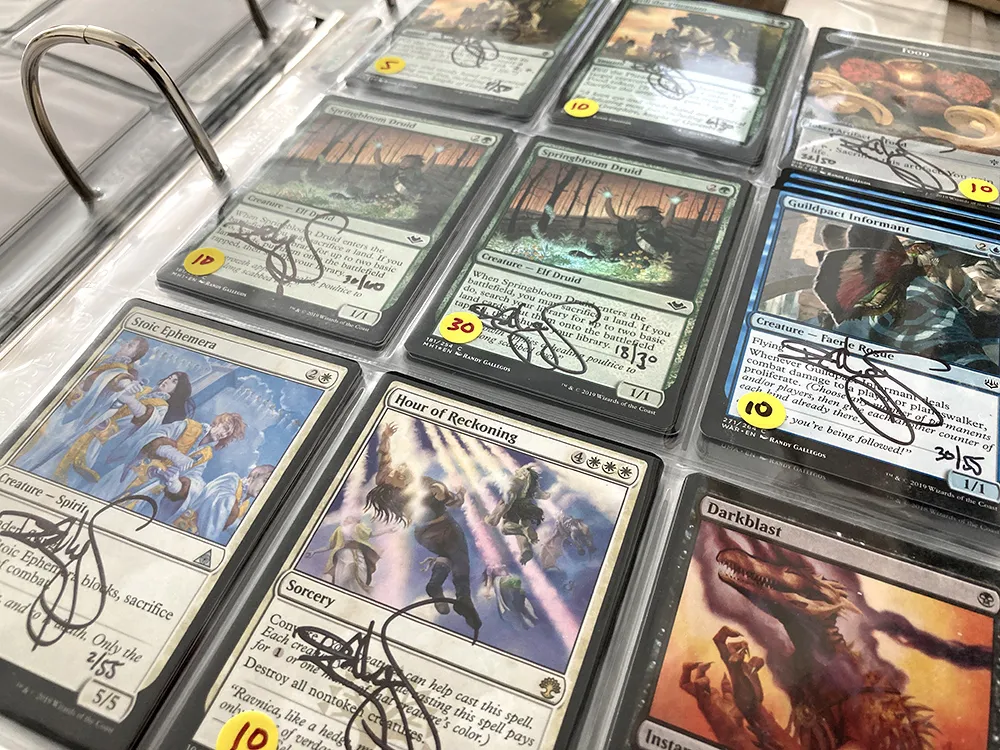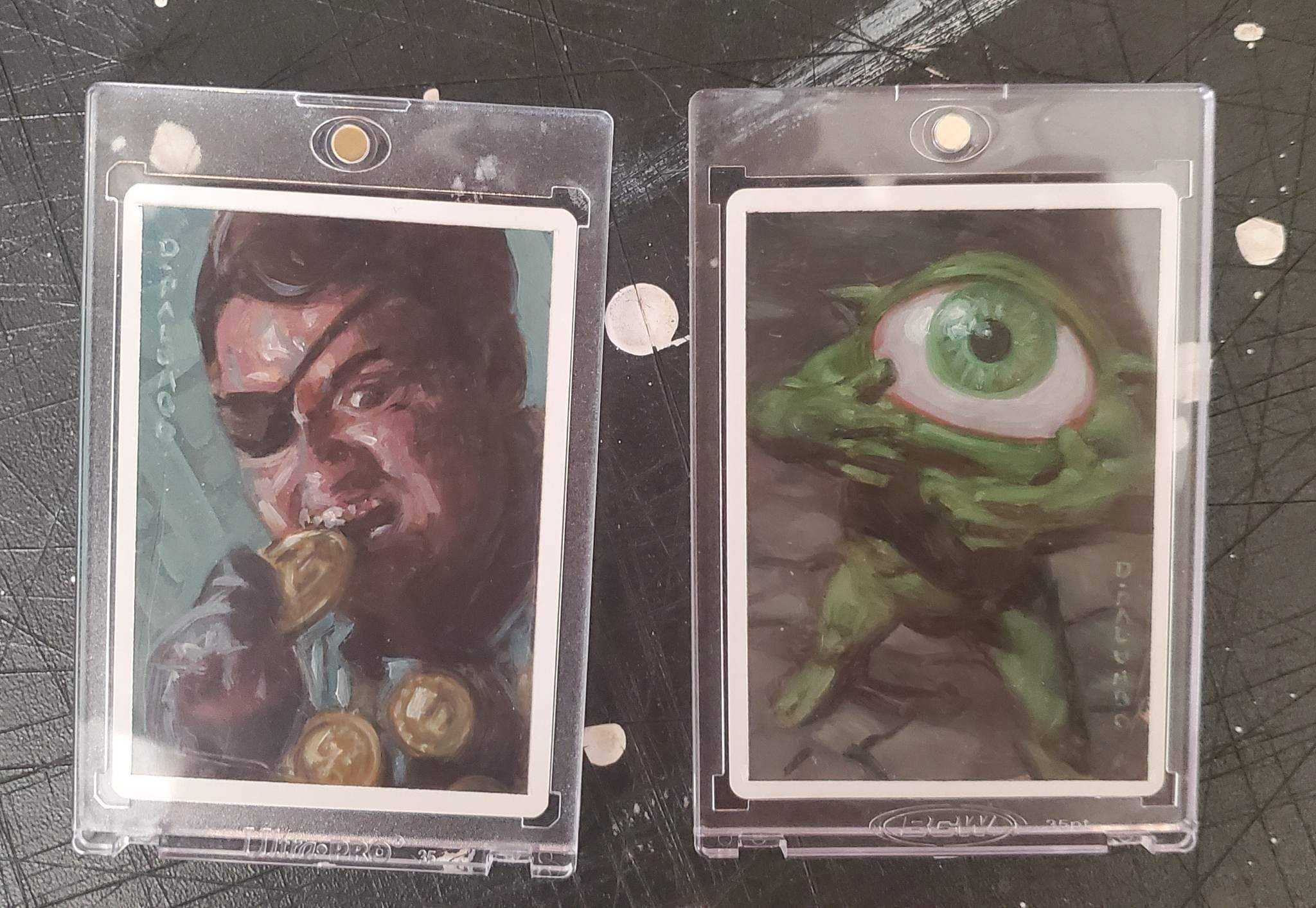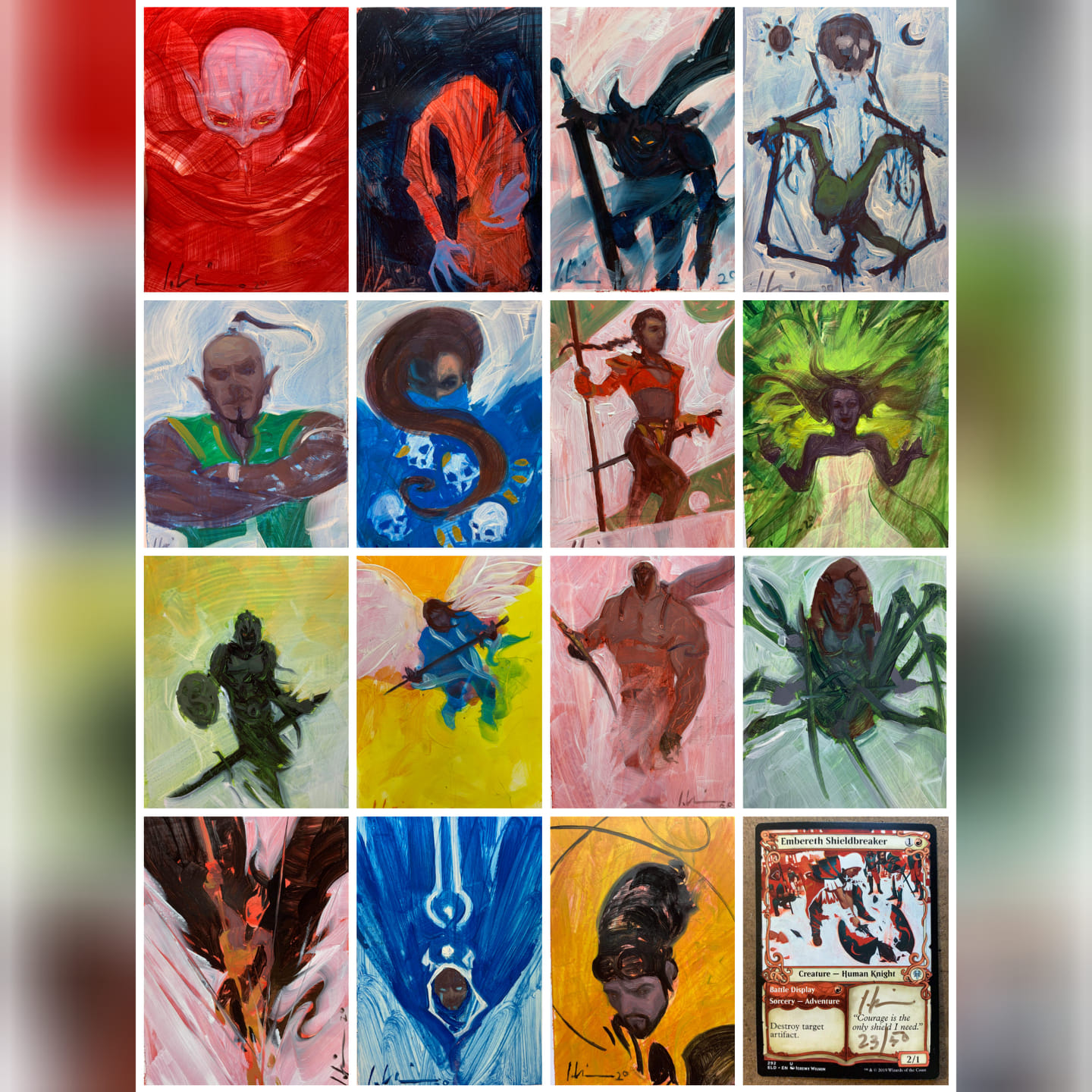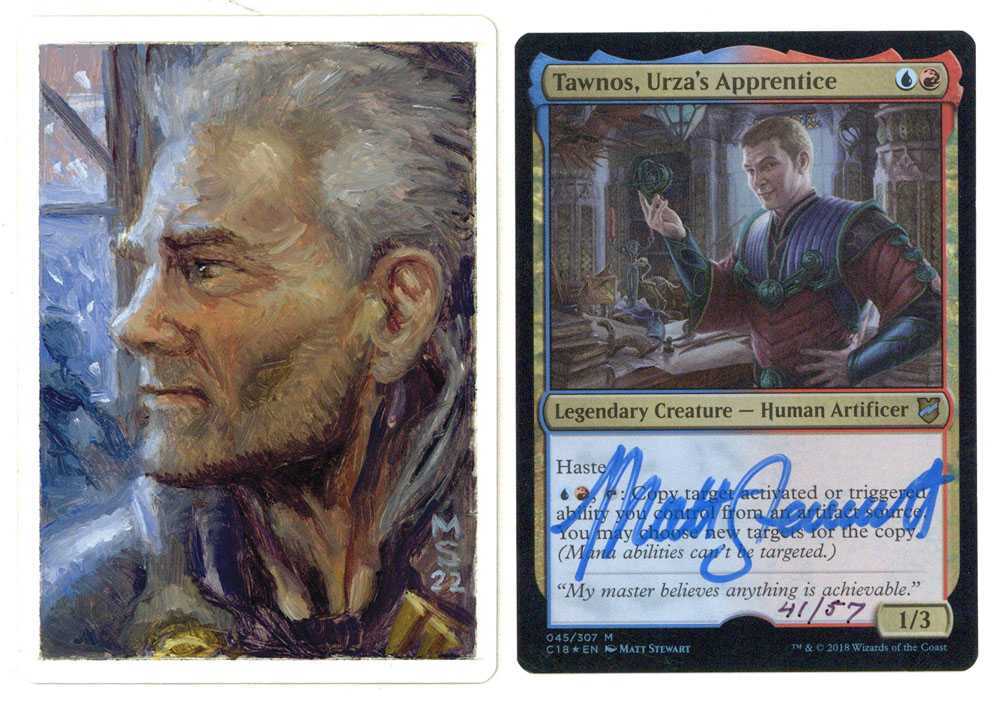Aesthetic Consultation: Magic in Miniature

Big Ideas, Tiny Art
Magic players are no stranger to tiny works of art. Every card printed features a unique illustration that's usually 2 inches by 1.5 inches in size, depending on the frame.
It's likely that Magic players are also aware that while the art on the card is about the size of four standard postage stamps, the art itself, when created, wasn't so minuscule. Some is painted digitally, with artists working on tablets or using monitors that are much, much larger than that, while others are physical illustrations measured easier in feet, not inches.
A new gallery exhibition opening later this month, however, offers to demonstrate what the talents of more than 40 Magic artists can create on a card itself.
Curated by Donny Caltrider, Senior Writer at Hipsters of the Coast and agent to more than a dozen Magic artists, the "Magic: The Gathering in Miniature Artist Proof Exhibition" opens at Nucleus in Alhambra, California on Jan. 21 and will run through Feb. 5. It's the first show of its kind for illustrated Magic Artist Proofs (APs), and following the in-person run at Nucleus, it'll be available to view online. For those in the area, a free reception is planned at Nucleus on opening night from 5-8 p.m. PST.

What is an Artist Proof?
In simplest terms, APs are Magic cards with white backs. Whenever an artist illustrates a card, Wizards of the Coast provides that artist with a limited number of APs. "They exist in extremely limited quantities, and thus are technically rarer than any regular card printed, although they are not tournament-legal," wrote Caltrider in an article about the subject. "They are only printed once per printing, meaning when an artist has sold or given away all APs from a given set, they are gone forever unless found again on the secondary market."
Frequently at in-person events featuring an artist alley, visitors will see those artists selling APs at their booths. An Artist Proof, or "whiteback," is a niche collector's item, but a unique one, which is part of its allure. "Whitebacks are a totally optional thing in Magic, just like Secret Lair drops to an extent," said Randy Gallegos. "But they represent a level of interest in the hobby that is just one step beyond the usual."
Gallegos is a veteran illustrator for Magic, with more than 100 cards to his credit dating back to Ice Age. Commander players likely recognize his name as the artist behind such popular cards in the format as Soul Warden, Vindictive Vampire, and Treasonous Ogre. "Early on in the history of Magic, Wizards came up with the idea for artist proofs," said Gallegos. "The company decided to print actual cards in fixed quantities, but with the card back left blank; hence the name 'whitebacks.'"
Those "Whitebacks" were then distributed to artists, solving some troublesome issues. "Artists were guaranteed copies of their art as printed, and issues of rarity and card value were taken off the table, since these weren't 'real' cards," Gallegos said. "Early on in my career, they proved tremendously useful. I even recall sending some away inside the physical portfolios I mailed to prospective clients."
The first set to include APs was Revised, though Gallegos points out that Beta APs exist, printed retroactively a few months following release. While APs were provided to the artists directly and were never available otherwise, it wasn't long before fans and collectors of the game saw them as sought-after. "After all, they are officially printed Wizards items, and as such, they are extremely rare," said Gallegos. "Typically, they are printed at only 50 copies per card. In fact, this was even stated in contracts with the artists going way back. So, if you see a Magic Whiteback in the wild, it's one of only 50 or so in the whole world."
Beginning in 2015, artists are also issued 30 foil APs per illustration, and Caltrider added that in 2020, tokens also began generating APs for artists. "Collectors are attracted to APs for lots of different reasons: collectability, scarcity, customization, the artwork, or just an interesting way to interact with the game," Caltrider said. "I talk a bit about this in (a recent) Rhystic Studies video (available here) -- it's something for everyone."
APs are a great way for artists to monetize their work, and an AP purchased from an artist at a show or from their website directly supports them. "APs still serve their original purpose that started 30 years ago, as a secondary income outlet for artists and a way for folks to showcase their work, and now more often than not, with more spectacular artwork on the back," Caltrider said. "Over the last 30 years, an entire subculture of collecting has been born out of these whitebacks, with many folks placing a large chunk of their MTG energy directly within this niche."
Gallegos said it's his estimation that Mark Poole was the first artist to start numbering their proofs, a common practice among most artists now. To further their collectibility, artists began illustrating that white back, or in other words, "natural canvasses," said Gallegos. "Drawing on the backs of them has been common from the beginning," he said. "With some prep, these cards can also receive acrylic and oil paint very well. You may find some cards available with custom art already on them, and frequently you can commission the artist to create something just for you."
For those interested in learning more about the hobby of collecting APs, head to Caltrider's article series, beginning aptly with AP101. "For those folks that are thinking about getting into APs, start slow and read all there is to read," Caltrider advised. "Find something you love, whether it's a deck, a card type, a creature type, an artist, a subject, a style, and use APs as a way to meet people, talk to artists, and put more great art out into the world. There are so many people doing cool things, the possibilities are endless."

Magic in Miniature
With the upcoming Nucleus show on the horizon, Artist Proofs -- and the illustrations they bear -- will take another step into the mainstream.
Caltrider credits the idea for the show to Magic art guru Vorthos Mike, who had visited a similar show at a Nucleus gallery in Portland, Oregon called "Power in Numbers." That show featured postcard-sized art sold at a fixed price, and he asked Caltrider why he hadn't done the same with APs. "I loved the idea, and that next week I reached out to Nucleus," said Caltrider. "They liked it, and after some logistical sorting I started working on the show as a Guest Curator in early October, which required it to move faster than I had intended, but was still very doable." With two weeks remaining before the show opens, Caltrider's amassed 41 artists, represented across nearly 150 APs in the first ever gallery show for Magic APs.
Caltrider began building the exhibition first with artists with whom he's most familiar, as well as pitching the idea to artists at events. "I usually start with those folks I work with regularly or know super well, and branch out from there," he said. "I was fortunate that IX Art Show and Magic 30 in Las Vegas were very close, and it afforded the opportunity to talk to a majority of the artists participating in person about what I was putting together." Word began to spread, with several artists referring their peers, "...and a few folks saw my show announcements and wanted to join, which was very exciting," Caltrider added.
As much as the prospect of being in a gallery exhibition for proofs was alluring, Caltrider said it was built first on trust. "An artist has to trust that I'll curate a show where their work will sell, and I trust that an artist will deliver unique and exciting artwork," he said. "Without that mutual trust, this would never happen." The work on display later this month at Nucleus will explore Magic's past and present, from planeswalkers to the Power Nine, depicted in all artistic manner, from pencil sketches to detailed inks up to full paintings in oils and acrylics. All pieces on display will be available to purchase with flat pricing based on medium. Pencil works will be $100, ink or non-painted color $200, and fully painted works will be $400.
Like any show, this one came with plenty of legwork needed to ensure a great experience for both attendees and the artists on display. Caltrider said there was "a lot of emailing from hotel rooms" while traveling throughout the year, as well as "a lot of discussion over dinner or drinks or coffee" that helped bring the show to life. "I know the folks that are a part of this would create something exceptional, and boy, did they ever," he said. "And they know I'll be able to successfully bring it to market like has never been done before."

Participating Artists
Magic: the Gathering in Miniature features 41 artists:
- Andrew Mar
- Justine Jones
- Lena Richards
- Carl Critchlow
- Cara Mitten
- Allen Douglas
- Bud Cook
- Titus Lunter
- Betty Jiang
- Matthew Stewart
- Chris Burdett
- Jarel Threat
- Ralph Horsley
- Bob Eggleton
- Sarah Finnigan
- Omar Rayyan
- Donato Giancola
- Alex Brock
- Drew Tucker
- Alan Pollack
- Jeff Menges
- Matt Stawicki
- Khurrum
- Ben Hill
- Aaron Miller
- Ilse Gort
- Jason Engle
- Brigette Roka
- Ryan Lee
- Evyn Fong
- Ben Schnuck
- David Palumbo
- Drew Baker
- Justin & Alexis Hernandez
- Bruce Brenneise
- Jeremy Wilson
- Greg Simanson
- Jeanne D'Angelo
- Jesper Myrfors
- Chuck Lukacs
- Martin Ontiveros
- Diego Andrade
Founded in 2004 by Ben Zhu, Nucleus "has strived to be a welcoming gathering place for the art loving community by offering quality art, art-related goods, and rarities." They routinely exhibit the work of artists both local and abroad, and, under the guidance of curator Nicki France, place an emphasis on illustration, animation, and narrative art. They are located in the San Gabriel valley in Alhambra, CA.
